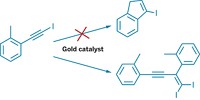Advertisement
Grab your lab coat. Let's get started
Welcome!
Welcome!
Create an account below to get 6 C&EN articles per month, receive newsletters and more - all free.
It seems this is your first time logging in online. Please enter the following information to continue.
As an ACS member you automatically get access to this site. All we need is few more details to create your reading experience.
Not you? Sign in with a different account.
Not you? Sign in with a different account.
ERROR 1
ERROR 1
ERROR 2
ERROR 2
ERROR 2
ERROR 2
ERROR 2
Password and Confirm password must match.
If you have an ACS member number, please enter it here so we can link this account to your membership. (optional)
ERROR 2
ACS values your privacy. By submitting your information, you are gaining access to C&EN and subscribing to our weekly newsletter. We use the information you provide to make your reading experience better, and we will never sell your data to third party members.
Synthesis
Grignard Radical Ensnared
A key organomagnesium intermediate in this textbook organic reaction has been trapped and studied for the first time
by Carmen Drahl
November 17, 2008
| A version of this story appeared in
Volume 86, Issue 46
A key radical intermediate in the Grignard reaction, a textbook reaction in organic synthesis, has been trapped and studied for the first time (Angew. Chem. Int. Ed. 2008, 47, 9118). The organomagnesium Grignard reagent generally reacts with a carbonyl compound to form an alcohol. Normally it acts as a nucleophile, but sometimes a radical mechanism is involved. Despite the reaction's broad use, researchers have never observed the presumed intermediate along the radical pathway, a magnesium ketyl radical. Richard A. J. O'Hair's team at the University of Melbourne, in Australia, managed to snag the intermediate in the gas phase. The team first formed the radical anion MgCl2·¯ in a mass spectrometer. They then reacted MgCl2·¯ with ketones to trap the intermediate and study its reactivity. Their results suggest that the ketyl radical plays a role in forming side products in some Grignard reactions. As a new radical reagent, MgCl2·¯ could aid studies of myriad organic and biological reactions, University of Utah professor and mass spectrometry expert Peter B. Armentrout notes.






Join the conversation
Contact the reporter
Submit a Letter to the Editor for publication
Engage with us on Twitter